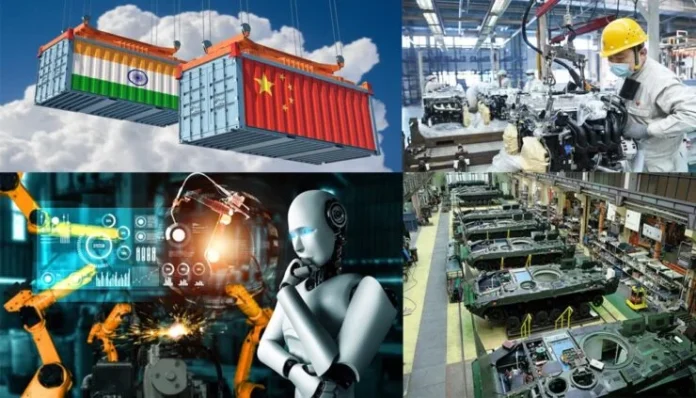The Prime Minister has set the objective that India must achieve the status of a fully developed country – Viksit Bharat – by 2047, the 100th anniversary of India’s independence. A fully developed nation is not just about high economic growth, infrastructure, technology, and military power but, more importantly, a high standard of living for its citizens in terms of income, health, and security.
So effectively, a developed status is better measured by per capita income. The current World Bank thresholds define the following levels: Income below $1085 as low income; $1085 to $4255 as low middle income; $4255 to $13205 as upper middle income; and above $13205 as high income. India, with a per capita GDP of $2523, falls into the low-income category, while China, with a per capita GDP of $ 12500, is in the upper middle-income category.
China is poised to enter the high-income level by 2025-26. The world order is currently in flux, with conflicts in Europe, the Middle East, and Africa and the return of great power competition involving Russia, China and much of the Global South on one side and the US-led West on the other.
India has been deftly navigating international political currents while keeping its national interests in focus. The on-going events indicate a rapidly evolving new world order. If India is to become a major power, able to set rules and standards for the new world order, it will mean it evolves as not only a major economic power but, more importantly, a significant technological, scientific, and military power with control and leadership over critical technologies. This daunting task can only be achieved through innovative strategies and robust policy implementation to make India the world’s leading manufacturing and innovative nation that rivals the growth of China.
Countering China
A 2003 analysis by the American intelligence on China predicted that as China’s capabilities and economic strengths crossed a certain threshold of national power, it would begin to flex its muscles. This time frame was assessed as 2008 to 2010.
In line with this report, we can see that the first problems of PLA intrusions in India, began in 2010, and the occurrences increased in frequency and aggressiveness over the years. The 2020 Galwan flashpoint was a serious skirmish leading to the loss of lives.
A Viksit Bharat should not be just about high economic growth, infrastructure, technology, and military power but, more importantly, a high standard of living for its citizens in terms of income, health, and security
China’s aggressive behaviour against India in the Himalayas appears paradoxical, considering that India-China trade has continued to grow significantly ($119 billion in 2023) during the same period, making China India’s largest trading partner. But what is clear is that China’s strategic objective is of becoming a global power, second to none by 2049.
In this context, China views India as a rival and impediment to achieving its strategic goals while also seeing India’s huge market that should be leveraged for China’s economic benefit. The growing strategic partnership between India and the USA, along with the emerging regional formations like the Quad, is viewed by China as an attempt to contain its logical growth.
China’s increasing presence and partnerships with countries around India and in the Indian Ocean, along with geo-economic projects such as the Belt and Road Initiative, spell a considerable challenge for India’s power and influence.
If India is to counter China, it needs to focus on narrowing the gap between the two countries over the next two decades. This will require a concerted effort in the rapid building of infrastructure, enhancing manufacturing and exports, increasing investments in education and human capital, and enhancing investments manifold in R&D that will result in significant innovations and leapfrogging development.
While India is today the fastest growing economy in the world, its per capita GDP is still low at US $2523. On the other hand, China’s economy is nearly six times larger than India’s, its per capita GDP is over US $12500, and its economy continues to grow at a good pace.
Putting China’s challenge in the correct Perspective
China is both a security threat and a strategic rival to India. Keeping China’s challenge in the correct perspective is vital to developing a robust strategy. Alvin Toffler, the well-known futurologist, described the emerging knowledge revolution that was taking hold in the industrial revolution-driven advanced economies in his massively popular books, Future Shock and The Third Wave, translated into many languages and in many countries.
Toffler’s The Third Wave was translated into Chinese and became a hugely popular book when China opened to the world in the late 1970s. Toffler stated that for countries like India and China, who missed the Industrial Revolution, rapid growth necessitated the countries to have one leg in the Industrial Revolution era of mass manufacturing while the other leg is firmly placed in the fast-evolving knowledge era of the world of computers and digital technologies.
China’s growth strategy of the last three decades reflects the influence of Tofflerian analysis, wherein one can see China as the world’s manufacturing giant and its rapid transition into a leading scientific and technological power.
China’s biggest strength is its colossal manufacturing capability in scale and sophistication. Early in the development cycle of a society, the best way to increase productivity is through manufacturing, as it provides employment to a large segment of the population and ensures up-skilling and further improvements.
The share of manufacturing sector in China’s GDP is nearly 30%, while India languishes at 13.3%. By investing heavily in education, infrastructure, and the development of human resources, China was able to transition rapidly into high-tech manufacturing.
It moved from producing low-end textiles and cheap consumer goods in the 1980s to a country with successful and large-scale automotive, shipbuilding, machinery, electronics, chemicals, and precision instruments industries. Chinese firms are important producers of ships, high-speed trains, mining and construction machinery, and power generation equipment, including nuclear reactors.
By creating massive scales of production, a very competitive internal environment, and ensuring government support through the right policies, Chinese firms out-competed and out-priced their competitors worldwide. Policies led to domestic competition, resulting in better prices and high quality. For example, China has 120 car companies in the car manufacturing sector and a fiercely competitive environment that spurs innovation and development.
China is the world’s manufacturing superpower that dominates the global market through its exports. It is the primary trading partner for 128 countries, i.e. two-third of the world. Its world-class infrastructure in terms of highways, high-speed railways, airports, seaports, and digital infrastructure has ensured China dominates the world’s manufacturing sector.
China’s growth strategy of the last three decades reflects the influence of Tofflerian analysis, wherein one can see China as the world’s manufacturing giant and its rapid transition into a leading scientific and technological power
Simultaneously, China has invested heavily in scientific and technological research and development over the last two decades and the results show. The Economist (June 2024) says China has become a scientific superpower, and the Chinese Academy of Sciences (CAS) is the world’s largest research organisation.
China has become the leading manufacturer of green energy products – from EV cars to solar panels and batteries. Today, Chinese scientists publish more research papers in peer-reviewed journals, including Nature Index, than America and Europe combined. The results are there to see not only in the civilian field but, more importantly, in the areas of military equipment, space, communications, and shipping.
China produces almost all its military equipment. Its military technology development aligns with its strategy of ‘Intelligentised Warfare’. Huawei is today the world’s leading communication technology industry. China’s rate of naval shipbuilding is massive and the most extensive in history.
In space capability and exploration, China is now a peer competitor to the USA. Its spaceship, Chang’e6, has collected Moon rock samples from the moon’s far side – a first in history – and is returning to Earth by next week. China is now a world leader in AI, robotics, biotechnology, quantum science, and communications technologies.
If India is to become a major power, able to set rules and standards for the new world order, it will mean it evolves as not only a major economic power but, more importantly, a significant technological, scientific, and military power with control and leadership over critical technologies
The data speak for themselves. As per the 2023 update of the OECD TiVA database, China’s manufacturing share in the world in terms of gross production is 35%, followed by the USA at 12%, Japan at 6%, Germany at 4%, and India at 3%.
China’s GDP today, as per Goldman Sachs, is US $18 trillion in dollar exchange terms. This is projected to increase to US $41.9 trillion in 2050 and $57 trillion in 2075. The per capita GDP will grow from $12500 today to $31900 in 2050 and $ 55400 in 2075.
China will overtake the US economy as the world’s largest economy around 2035. This is around ten years later than earlier projections by Goldman Sachs in 2011, primarily reflecting downward revisions made to Chinese potential growth.
All the above data indicates that China, in 2047, will be able to exercise its power more forcefully in geopolitical, economic, and technological spheres. This can only be countered by an India that is comparably powerful and is allied with other great powers.
Recrafting and fine-tuning India’s Strategy
India’s strategy for its growth needs aggressive recrafting, fine-tuning, and forceful implementation. Since the 1950s, India has always been seen as the most promising rising power and a country of the future, a counter to China, but only to disappoint, due to its inconsistent growth, specifically in terms of industrialisation and development of its human resources.
India is today the fifth largest economy, at US $3.6 trillion. While China announced in 2022 the total eradication of poverty in China, India still must contend with nearly 13% of its population below the poverty line. In terms of military power, notwithstanding the implementation of the Aatmanirbar Bharat policy, India is still largely dependent on foreign military technology and equipment. This starkly contrasts with China, which now fields considerably advanced military technologies and platforms that rival the US.
Data indicates that China, in 2047, will be able to exercise its power more forcefully in geopolitical, economic, and technological spheres. This can only be countered by an India that is comparably powerful and is allied with other great powers like the US
India must address its manufacturing deficit with aggressive policies to attract FDI and industrialisation. Manufacturing needs to improve from the current 13.3% to at least 26% of the GDP in the short term. This objective was set as early as 2014, but no improvement has occurred.
This calls for substantial reassessment of policies and implementation. Indian leadership and people need to shelve rhetoric and take a hard look at the ground realities to recraft its strategies.
While the talk of supply chain relocations from China to other countries, more specifically India, has been on since the start of the US-China trade war, the truth is quite different. The shift is likely to be marginal. On the other hand, as India looks to hi-tech industries establishing their manufacturing here, we need to consider the emerging challenges of de-globalisation, protectionism, and geopolitical headwinds.
According to the IMF World Economic Outlook Database, India’s last decadal average growth rate is 5.9% in current US dollars. If this is taken as the average growth rate for baseline projection, India will become a US $5 trillion economy by 2029-30 and a $10 trillion economy and upper middle-income country by 2040-41.
However, according to India’s former RBI governor, Dr C Rangarajan, if Indian economy grew continuously at 7% over the next 20 years, then it might become a developed economy.
Alok Sheel, former Secretary of PM’s Economic Advisory Council, observes that sustaining a 7% growth rate in the current growth environment is not easy. India’s national income is currently where China was in 2006-07, whereas China is on the verge of becoming a high-income country.
In 2006-07, India’s per capita income was about 38% of China’s; today it is just 18%. If India were to grow as per last decadal growth, it would reach China’s current level of $17 trillion only around the mid-century.
India’s strategy for its growth needs aggressive recrafting, fine-tuning, and forceful implementation. India must address its manufacturing deficit with aggressive policies to attract FDI and industrialisation. Manufacturing needs to improve from the current 13.3% to at least 26% of the GDP in the short term
In other words, during the last three decades, beginning from a position of rough parity, China has moved ahead of India by about three decades. How far ahead might China move during the next three? This is a clear indication that India will need major policy reforms and sustained implementation to grow at a significant pace if it is able to counter China in 2047.
Barriers and Opportunities: Innovation is the Key
India’s barriers stem from many internal factors: self-serving politics, poor education and skilling infrastructure, lack of a culture of discipline and commitment, slow infrastructure growth hampered by legal and policy paralysis, and a low share of the manufacturing sector.
The government’s low investment in R&D has led to excessive technology dependency on external sources. Policy reforms since the 1990s have addressed some of these barriers, but the process has been prolonged, resulting in missed opportunities.
However, there are also significant opportunities for India. The first is the demographic dividend, a sweet spot that India is in, which will accelerate production. The demographic dividend is the large working-age population of the 15-64 age group, expected to be 1.04 billion by 2030, with a dependency ratio to be the lowest in history at 31.2%.
While India will have this window till about 2055, China is becoming a rapidly ageing population and will touch a dependency ratio of 70% by 2050. If India crafts the right policies and plays its cards right, both domestically (expand education and health) and geopolitically (closer alignment with the USA), this demographic dividend could add 1.5 to 2.0% to its trend growth, which effectively means India could realise close to 8% growth scenario.
According to India’s former RBI governor, Dr C Rangarajan, if India grew continuously at 7% over the next 20 years, it might become a developed economy. Alok Sheel, former Secretary of PM’s Economic Advisory Council, observes that sustaining a 7% growth rate in the current growth environment is not easy. Hence, India needs major policy reforms to grow at a significant pace to counter China in 2047
The second is India’s vast potential in its technology start-ups and the innovation climate. With recent changes in policy and the opening of public sector resources and infrastructure for research and development, India’s young technocrats are showing great promise.
This is evident in the space and defence sectors. The recent success of the start-up venture AgniKul Cosmos’ small satellite launch with its 3D-manufactured semi-cryogenic engine shows excellent promise for technology innovation in the civil sector.
Similar start-up success ventures are evident in drone manufacture, weapon systems, and electronic hardware. India will need to focus on innovation and disruption with IR 4.0 as the sure strategy to enter the vast new age of manufacturing and become a trusted supplier of high-quality products at competitive prices.
India’s strategy for a ‘Green Economy’ can propel it to leadership in a world that urgently needs a green transition. India’s ambitious targets of installing 550 gigawatts of renewable energy capacity, installing 5 million tons of green hydrogen annually, and cutting emissions by 45% and a billion tons of CO2 by 2030 is a massive opportunity for technology innovations and manufacturing.
A 2021 report by the World Economic Forum projects 50 million net new ‘green economy’ jobs in India, which means more consumers and $15 trillion in economic opportunity by 2070, with $2 trillion by 2030.
Goldman Sachs projects the Indian economy to become $ 22.2 trillion by 2050, just half of China’s economy – a massive transformation from being one-sixth today. This gap is projected to reduce considerably in 2075 when India becomes a $ 52.5 trillion economy against China’s $ 57 trillion. At that point, India will still be primarily a young population while China will be significantly an ageing population
India in 2050: what the future holds
For a long time, India has remained a country with promise but unrealised potential. If India is to become a great power alongside China and the USA, it needs to be a significant economic, technological, and military power.
Blessed with a vast young population, India must harness this demographic dividend to produce innovative solutions to its development and security challenges. India’s accelerated development can only happen when its strategies are focused on large-scale manufacturing, export orientation, and the rapid improvement of its population with a higher per capita income.
Despite poor policy implementations, India will continue to grow because of its aspirational young population. In a conservative and realistic estimate, Goldman Sachs projects the Indian economy to become $22.2 trillion by 2050, just half of China’s economy – a massive transformation from being one-sixth today.
If only more aggressive policies and strategies are enforced along social and human reform investments, India could easily achieve higher growth and narrow the gap with China.
This, however, is projected to reduce considerably in 2075 when India becomes a $52.5 trillion economy as against China’s $57 trillion. At that point, India will still be primarily a young population while China will be significantly an ageing population.
–The writer is a former Deputy Chief of Integrated Defence Staff for Policy, Plans, & Force Development (DCIDS – PP & FD). He is currently the President of The Peninsula Foundation, a Chennai-based public policy research think tank.The views expressed are personal and do not necessarily reflect the views of Raksha Anirveda
–The writer, a AVSM VM PhD (V) is a former Deputy Chief of Integrated Defence Staff for Policy, Plans, & Force Development (DCIDS – PP & FD). He is currently the President of The Peninsula Foundation, a Chennai-based public policy research think tank. The views expressed are of the writer and do not necessarily reflect the views of Raksha Anirveda










